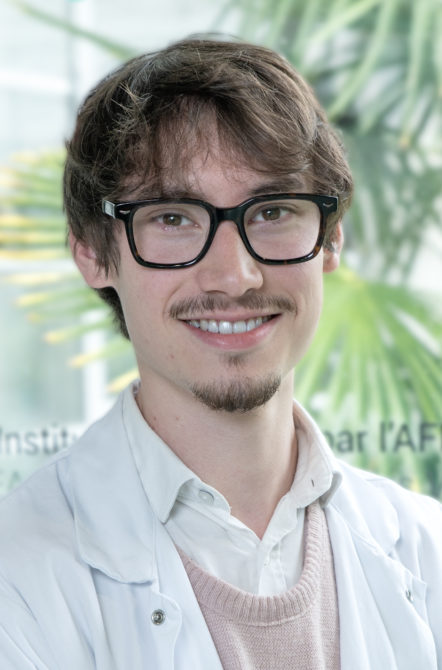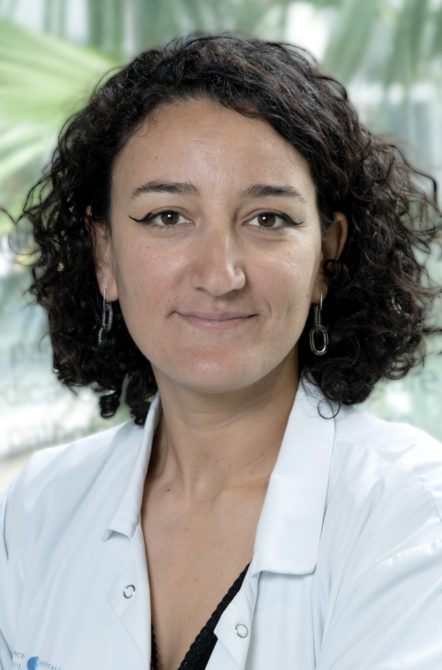

Sabrina Sayah and Thibaud Guillopé are clinical psychologists specialising in neuropsychology in the Psychology and Neuropsychology team at the Institute of Myology. They presented their clinical work at the Neuroscience DMU Day held at the ICM on 22 June. Their poster having been selected, T. Guillopé was able to give an oral presentation of the initial feedback from the remediation group run with DM1 patients. DM1, also known as Steinert disease, is the most common neuromuscular disease in adults, and is also the most frequently encountered in the Institute’s Neuromyology Department. Interview with Sabrina Sayah and Thibaud Guillopé.
How did this work come about?
Sabrina Sayah: I’d had a remediation group for Steinert patients in mind for a long time, but the project was put into practice when Thibaud arrived at the end of 2022. In particular, I had a patient with DM1 for whom I felt that individual follow-up was running out of steam, and this was an opportunity to propose something different.
Thibaud Guillopé: The idea here is to involve the patients in something group-based and to work together on social cognition difficulties. Some DM1 patients sometimes have difficulty putting themselves in other people’s shoes and adapting socially to the people they are talking to. They can become irritable or even aggressive, and the filter can be lifted: patients can be very direct, which can lead to rather embarrassing and complicated social situations for them.
SS: The idea is to help them take a step back and look at how they operate from the outside, and to help them understand what they can change to feel more at ease in various social situations. We also work on asking for help: how not to feel guilty or uncomfortable in this position.
Can you describe the approach you have adopted?
TG: On the advice of Bettina Beaujard, who is a clinical psychologist in the team and has worked in psychiatry in the past, we chose a card game called ‘Compétences‘ (skills). There are three categories of cards*: the green questions focus on explicit knowledge of social cognition in general, and how to relate to others.
The other two types of cards propose situations in which patients must either act out their reactions (red cards) or describe the solutions they propose for a given problem (blue cards). The colour of the card to be played is drawn from the die.
SS: The person who draws the die is allowed to play/answer, then the others are asked if they would have done things differently, and this opens up the discussion. The patients’ favourite cards are the red ones! As well as being fun, this game allows us to tackle both theoretical and practical issues, as well as problem solving. It also allows us to work on our executive functions, which enable us to divide up and plan the steps needed to solve a given problem, and then put in place a solution to best respond to a social situation.
This game is training in social skills – the more you do it, the stronger you get, just like sport!
How did you recruit your patients to form this group?
SS: We each met individually with patients who had been in our care for a long time or whom we met during day hospitalisation, and for whom we thought it would be interesting to propose this group. These could be patients who were well aware of their difficulty in relating to others, but also, in some cases, people who didn’t understand why they were finding it hard to make friends or keep a job. The group was presented as a tool to facilitate social contact with others.
TG: There may have been some reluctance, because of the unknown aspect but also the embarrassment of admitting that you have difficulties.
SS: It’s also sometimes difficult for DM1 patients to start a new type of treatment, because anything that doesn’t immediately seem necessary or useful comes up against a fairly inflexible attitude. Implementing changes in daily life can be very costly emotionally and cognitively, and can also cause a great deal of stress and anxiety. It was therefore important to explain the group’s procedures in advance, such as the number of sessions, the length of the sessions and the benefits of coming and taking part. This gave the patient time to think about it before embarking on the adventure. We wanted patients to join the group voluntarily. The disease already imposes a huge number of constraints, so there was no question of imposing yet another layer of care.
Specifically, which group did you form and how did the sessions go?
SS: The group consists of 6 patients, 4 women and 2 men, at different stages of the disease and with fairly heterogeneous levels of motor and cognitive impairment. We have scheduled twelve 1.5-hour sessions on Friday afternoons, once a month. The sessions with this group will end in January 2025, and then we will start a new cycle of 12 sessions with a new group.
TG: But it seems that the patients are going to find it hard to stop, there’s a great atmosphere! Although there was a bit of mistrust at the beginning, it soon gave way to a good understanding. We used another game to break the ice and introduce ourselves during the first two sessions, ‘Dixit’.
SS: In fact, Thibaud and I also play during the sessions! I think it’s really important that we play, because we bring an outside perspective and a slightly different way of doing things. It’s also a way of being together, of encouraging the group dynamic and not being seen as ‘assessors’. We show that there is no perfect answer to a social situation.
What did you learn from these sessions?
SS: The group achieved a number of things for the patients, in particular an effect that we hadn’t anticipated at all: the fact that they were able to discuss together the medical monitoring of their illness and very specific therapeutic issues (pacemaker, NIV, etc.). They probably felt less alone thanks to this sharing of experience, and the changes seemed less frightening. For example, one patient who had previously refused to have a pacemaker fitted finally agreed, telling her doctor that the group had changed her mind. Exchanging with other people who had already had a pacemaker fitted, and with whom a feeling of trust developed over the course of the sessions, reduced this patient’s anxiety in the face of this new and frightening situation. The patients also realised that they might have slightly inappropriate ways of communicating, or that in certain situations they tended to respond impulsively or aggressively. During the group, they were able to experience that other responses were possible and that people could react differently.
Have you heard any feedback from patients?
SS: Some patients have told us that they feel calmer with other people in their daily lives.
TG: I’ve also noticed that they’ve really appreciated being able to freely express themselves, to feel the cohesion of the group and its good understanding. They emphasised that they had learnt about the disease in general, which may have led some of them to resume their medical treatment. They also reported feeling less aggressive and more able to manage their emotions. Finally, they appreciated the small number of participants and said that they had felt at ease with other people suffering from the same disease. The members of the group also mentioned the idea of setting up another more general discussion group.
Will you be continuing this type of work?
SS: We’re going to finish the 12 sessions with this first pilot project, which has already been a success for us and for the patients. This new way of working is very stimulating.
We’d like to be able to objectivise the beneficial effects observed using psychological scales: for emotional regulation, self-awareness or anxiety, or using tests to evaluate before and after the 12 remediation sessions. The evaluation criteria have yet to be determined. This is the objective of the next group.
More broadly, the group could be offered to patients with other MNDs presenting cognitive difficulties, such as Duchenne or Becker muscular dystrophy.
* The questions are asked in order from the simplest to the most complex.
Examples of green questions: ‘Name three important points when responding to a compliment’ or ‘What behaviours tell you that someone is sad?’
Example of a red question: ‘You want to play a board game with your work colleagues at lunchtime, and your neighbour on the right is playing your colleague.’
Example of a blue question: ‘A stranger insults you in the street, what do you do?’
